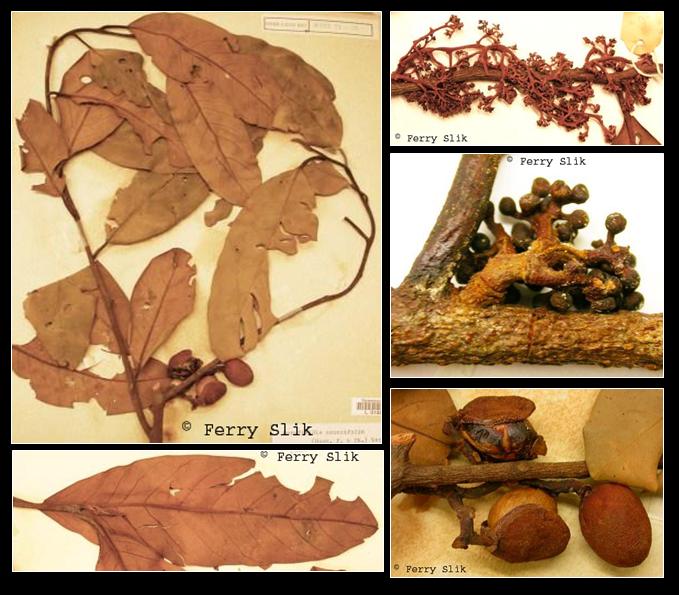Horsfieldia crassifolia (Hook.f. & Thomson) Warb., Mon. Myrist. (1897)
Latin for 'thick leaves'.Synonyms
Horsfieldia fulva var. paludicola (King) Warb.
Myristica crassifolia Hook.f. & Thomson
Myristica irya var. crassifolia Miq. ex Hook.f.
Myristica paludicola King
Diagnostics
Upper canopy tree up to 41 m tall and 36 cm dbh. Stem with red sap. Stipules
absent. Leaves alternate, simple, penni-veined, hairy below. Flowers ca. 2 mm
diameter, white-yellow, placed in panicles. Fruits ca. 19 mm long, yellowish,
glabrous, dehiscent capsule. Seeds with entire aril.
Description
Tree 10-25(-41) m. Twigs 2-6(-8) mm diameter, rather early glabrescent, hairs yellow brown
or rusty, woolly, 0.2-0.5 mm; bark coarsely striate, not flaking; lenticels sparse to
dense, distinct or not. Leaves coriaceous, elliptic to oblong, 10-20(-28) by 3.5-7(-10)
cm, base rounded to attenuate, apex rounded to subacute or rarely emarginate; upper
surface drying dull greenish brown to dark brown, lower surface +/- covered with subpersistent
interwoven or spaced stellate scale-like hairs 0.1 mm high (when very young
with dendroid emergents), or glabrescent and then showing distinct hair scars, and scattered
dots and dashes; midrib above flattish; nerves 11-16 pairs, above thin and flat or
sunken; venation faint on both surfaces; petiole 9-20(-30) by 1.5-4.5 mm, leaf bud
7-12 by 2-3 mm with hairs 0.2-0.5 mm. Inflorescences among or behind the leaves, late
glabrescent or with persistent, dense, woolly dendroid hairs 0.2-0.5 mm; in male: 3-5
times branched, broadly paniculate, many-flowered, 6-20 by 4-15 cm, peduncle 0.5-2
cm long; in female: 3-14 cm long; bracts elliptic-lanceolate, 2-5(-7) mm long, pubescent,
caducous; flowers (male) in loose clusters of 2-7, glabrous; perianth 2-lobed, pedicel
slender, not articulated. Male flowers: pedicel (0.3-)1 mm long; buds globose or
slightly transversely ellipsoid, (0.8-)1-1.3 by 1-1.5 mm, cleft l/3-l/2(-2/3), lobes 0.2-
0.3 mm thick; androecium globose or +/- transversely ellipsoid, barely laterally compressed,
0.4-0.5 by 0.5-0.8 mm, thecae (6-)8-12, widely spaced, connectives
broad (and androecium angular), the anthers free for almost the upper half or more;
androphore 0.2(-0.3) mm long, slender. Female flowers: pedicel 1.5-2.5 mm long; buds
broadly obovoid, 2-3 by 2-2.5 mm, cleft 1/5-1/3, lobes 0.6-1 mm thick; ovary obovoid,
glabrous, 1.5 by 1.2-1.5 mm, stigma of 2 sessile small lobes 0.1-0.2 mm high, running
out into a faint ridge at one side of the ovary. Fruits (1-)2-10 per infructescence, ovoid
to obovoid, 1.5-2.2 by 1.2-1.8 cm, glabrous, drying dark brown, with at most few lenticel-
like tubercles; pericarp 1.5-2 mm thick; fruiting pedicel 2-5(-7) mm long; perianth
persistent. [from Flora Malesiana]
Ecology
In undisturbed (peat)-swamp and keranga forests up to 200 m altitude.
Usually in alluvial sites with sandy soils.
Distribution
Peninsular Thailand, Peninsular Malaysia, Sumatra, Borneo.
Local names
Borneo: Darah-darah, Kumpang, Kumpang burung, Kumpang paya, Mandarahan.
